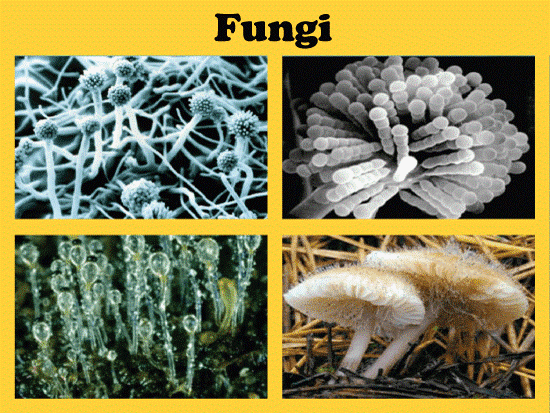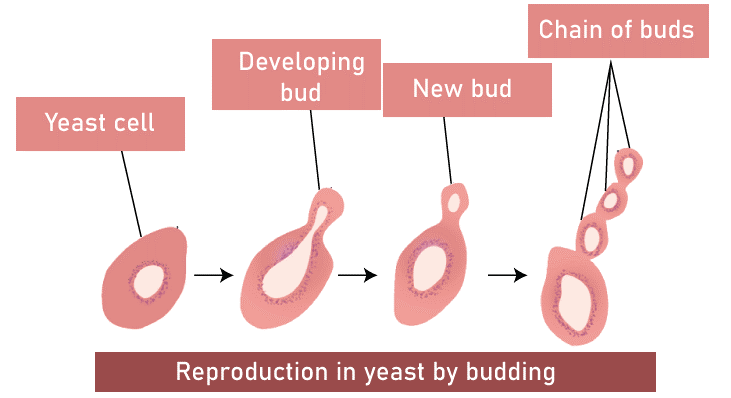Fungi DefinitionA fungus, or fungi in the plural, is a living creature that can contain yeasts, molds, mushrooms, and other things. The tiny hyphae, thread-like cells found on fungi, absorb nutrients and keep the fungus in place. Some have a body made up of many cells, like mushrooms. Unlike plants with chlorophyll to absorb energy from sunlight, fungi do not. They are instead nourished by ingesting and absorbing the dead organic materials around them. Mycology is the study of fungi. 
Fungi are a distinct kingdom of living organisms, apart from animals & plants. In contrast to bacteria, fungi contain nuclei in their cells. Hyphae sometimes have many nuclei. They have chitin-based cell walls as opposed to cellulose-based plant cell walls. The fungus is differentiated from other groups of similar creatures by these and other characteristics. The fungi are referred to as Eumycota or Eumycetes. Let's examine the structure, classification, and characteristics of fungi in depth. Structure of FungiThe following points can be used to describe the structure of fungi:
Characteristics of FungiThe following are important fungi characteristics:
Classification of the FungiKingdom of Fungi Various approaches are used to categorize fungi. The several categories of fungus are as follows: Based on Nutritional Mode The fungi kingdom can be divided into three divisions based on their nutritional composition. Saprophytic- The fungus is saprophytic, which means they rely on decomposing organic matter to stay alive. Rhizopus, Penicillium, & Aspergillus are other examples. Parasitic- Fungi that consume and receive nutrition from living things, like animals or plants, are referred to in this term. Examples include Puccinia and Taphrina. Symbiotic- To thrive, these fungi have a mutually beneficial symbiotic connection with other species. Two examples are mycorrhiza and lichens. Lichens are a product of the symbiotic connection between algae and fungi. In this situation, both algae and fungi benefit because fungi defend algae, and algae, in turn, feed fungi with carbohydrates. Mycorrhiza is the name for the symbiotic interaction that exists between fungi and plants. While plants provide fungi with organic substances like sugar, fungi assist plants in better-absorbing nutrients. Based on Spore Formation Kingdom fungi are categorized into the following categories based on spore formation: Zygomycetes- These are produced when two unique cells come together. Sporangiospores are asexual spores, whereas zygospores are sexual spores. The hyphae don't have any septa. For instance, mucor. Ascomycetes- It is also referred to as sac fungus. They might be coprophilous, saprophytic, decomposers, parasitic, or any of these. Sexual spores include ascospores. Conidiospores aid asexual reproduction. Saccharomyces is one example. Basidiomycetes- The most prevalent basidiomycetes are mushrooms, which mainly survive as parasites. Sexual reproduction occurs in basidiospores. Asexual reproduction can occur by conidia, budding, or fragmentation. An example is Agaricus. Deuteromycetes- Because they don't reproduce using the same cycle as the other fungus, these fungi are sometimes referred to as imperfect fungi. They do not procreate sexually. The means of asexual reproduction are conidia. One example is trichomoniasis. Reproduction in Fungi
Fungi can reproduce both sexually and asexually. The terms "teleomorph" & "anamorph" are used to describe the sexual and asexual modes of reproduction, respectively. Vegetative reproduction- In fungi, vegetative reproduction occurs by budding, fission, and fragmentation. Asexual reproduction- Asexual reproduction involves the usage of spores such as conidia, zoospores, or sporangiospores. Sexual reproduction- Sexual reproduction occurs via oospores, ascospores, & basidiospores. Uses of FungiFungi are among the most significant groupings of living things since they are essential to the biosphere and have significant economic value due to their beneficial and harmful impacts. The following are some significant applications for fungi: Recycling- They significantly impact the recycling of decomposing and dead waste. Food- The cultivated mushrooms are edible and therefore consumed by people. A certain fungus species must be introduced to certain kinds of cheese. These cheeses include Camembert and blue cheese, for instance. The cheese has a distinct flavor and texture thanks to the fungus. Medicines- Antibiotics and treatments for ailments in both people and animals are made from a variety of fungi. Penicillium, a widespread fungus, is where the antibiotic penicillin originates. The ConclusionFungi are a significant component of soil biodiversity, and this wide range of organisms can assist in addressing issues like hunger and climate change. Fungi and plants, as well as the cycle of nutrients and carbon, are closely related.
Next TopicGDP Definition
|
 For Videos Join Our Youtube Channel: Join Now
For Videos Join Our Youtube Channel: Join Now
Feedback
- Send your Feedback to [email protected]
Help Others, Please Share










